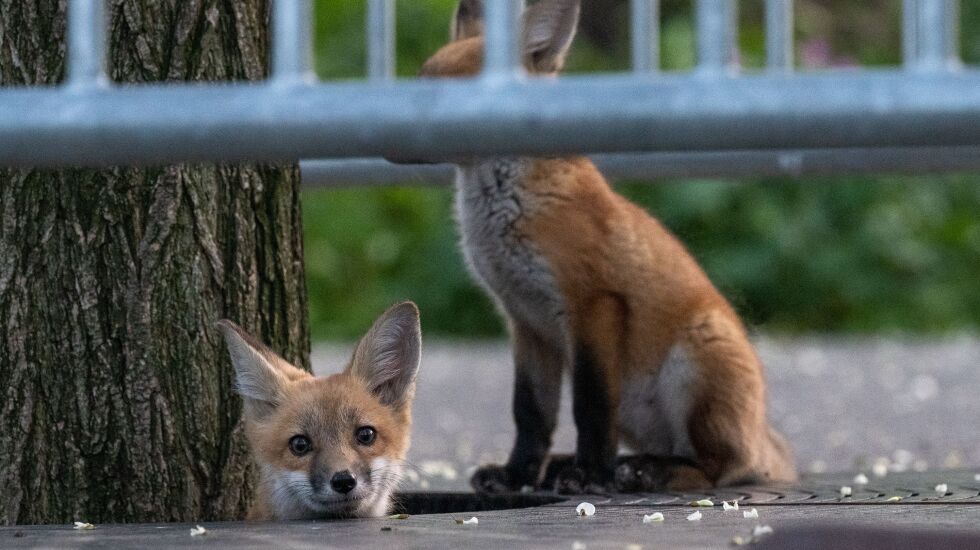
A young, dynamic family just moved into spacious property near the lake in downtown Chicago.
No, not the brood of some crypto-billionaire. A family of foxes has taken up residence in Millennium Park.

At least four small fox kits were seen loping around the park’s Lurie Garden late Monday evening, jumping in and out of their den as surprised visitors stopped to sneak a picture of the furry family.
The small canids nipped at each other and chased their tails around the garden. They groomed one another and ran in and out of greenery in the park.
A Reddit user and photographer sparked curiosity about the animals after posting images of the young foxes in the Chicago subreddit.
Liza Lehrer, assistant director of the Urban Wildlife Institute, said her organization has been in contact with staff at the park about the foxes.
Staff have observed the kits hunting and exhibiting natural behavior, which indicates that they haven’t become reliant on humans.
“There’s a lot of great things that they’re foraging,” Lehrer said. “They’re displaying a lot of really positive natural behaviors, they’re hunting birds and small mammals and things like that.” She said the kits have been seen in the garden alongside their mom.
Kathryn Deery, head horticulturalist at the garden, said staff have spotted up to six fox kits and two adults: a male and a female.
Deery said the staff is excited about the family, and they will adjust barriers and stanchions around their den as more visitors head to the park to catch a glimpse of the babies. Additional signage will be added as well, she said.
In 2021, Chicago Animal Care and Control in partnership with Lincoln Park Zoo’s Urban Wildlife Institute released a Wildlife Management and Coexistence Plan.
The plan outlined best practices to reduce conflicts and help people live alongside wildlife and nature in the Chicago area. That includes not feeding the young foxes, as cute as they may be, Lehrer said.
“We encourage folks to really appreciate the nature that’s around them and really just observe, don’t disturb,” Lehrer said. “So keep your distance around wildlife, certainly, and give them a lot of space.”

Foxes are omnivores, meaning they eat a variety of things, including insects, reptiles, rabbits, birds and fruit. They do most of their hunting at night.
Lehrer said the foxes may have chosen the park as a home to avoid coyotes, which are thought to be their main competition for habitat. Coyotes prefer to stay in locations with lower human activity and have a lot of room to roam. Coyotes are also known to kill foxes to reduce their competition.
“We think the red foxes are kind of hanging out more in residential areas and certain pockets where they can avoid coyotes,” Lehrer said. “And you know, Millennium Park might be one of those really great spaces, even though there’s more human activity there.”
The foxes have probably figured out how to safely navigate the busy streets surrounding the park.
“We don’t know exactly when they’re crossing these roads, but maybe they’re finding times where the traffic is lower,” Lehrer said. “They’re more active at night. So I suspect that they’re probably crossing those bigger roads later at night where the traffic is lower, and maybe they just sort of figured out the best times to do it.”
Red foxes are typically smaller than coyotes, weighing 7 to 15 pounds, on average, and standing up to 20 inches at the shoulder. They are generally solitary and do not form packs.
They are native to the area but are only present in certain areas of the city and don’t have a high population count. It’s hard to get a good estimate on their total numbers because foxes are difficult to track, Lehrer said.
But a clue can be found in the institute’s biodiversity monitoring study, which has been going on for 13 years, Lehrer said. As part of the study, the institute keeps tabs on 100 locations in the Chicago area using trail cameras. Lehrer said a recent analysis of those sites found foxes present in about 13 of those locations.

The fox family is sure to join the list of viral Chicago critters in recent years. That list includes piping plover lovers Monty and Rose, massive snapping turtle “Chonkosaurus” and famed alligator “Chance the Snapper.”
Lehrer said the furry family is just a small example of the diverse fauna that call the city home.
“There’s tons of different wildlife that live in Chicago, all kinds of mammals and birds and reptiles that, if you just kind of take a close look, you’ll really be able to see how biodiverse the Chicago area really is,” Lehrer said.







